
The Ussuri or Wusuli is a river that runs through Khabarovsk and Primorsky Krais, Russia and the southeast region of Northeast China. It rises in the Sikhote-Alin mountain range, flowing north and forming part of the Sino-Russian border, until it joins the Amur as a tributary to it near Khabarovsk. It is approximately 897 km (557 mi) long. The Ussuri drains the Ussuri basin, which covers 193,000 km2 (75,000 sq mi). Its waters come from rain (60%), snow (30–35%), and subterranean springs. The average discharge is 1,620 m3/s (57,000 cu ft/s), and the average elevation is 1,682 metres (5,518 ft).

The purple hairstreak is a butterfly in the family Lycaenidae distributed throughout much of Europe, North Africa, Anatolia, Caucasia, and Transcaucasia. The larva feeds on Quercus robur, Quercus petraea, Quercus cerris and Quercus ilex.

Favonius is a Palearctic genus of butterflies in the family Lycaenidae.

Katha depressa, the buff footman, is a moth of the family Erebidae found in Asia and Europe. It was first described by Eugenius Johann Christoph Esper in 1787.
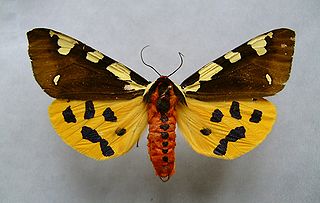
Arctia is species of tiger moth in the family Erebidae. It was first described by Carl Linnaeus in his 1758 10th edition of Systema Naturae. It can be found in central and eastern Europe, Kazakhstan, southern Siberia, northern Mongolia, Amur Region, Primorye, Sakhalin, Kunashir, northern and northeastern China, Korea and Japan.
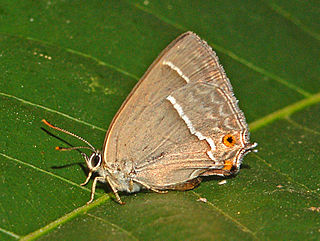
Neozephyrus is a genus of butterflies in the family Lycaenidae. Species in this genus are mainly distributed in East Asia. The larval food plant is alder or - for Neozephyrus quercus - oak.

The Ussuri brown bear, also known as the Ezo brown bear, Russian grizzly bear, or the black grizzly bear, is a subspecies of the brown bear or a population of the Eurasian brown bear. One of the largest brown bears, a very large Ussuri brown bear may approach the Kodiak bear in size. It is not to be confused with the North American grizzly bear.

The Amur leopard is a leopard subspecies native to the Primorye region of southeastern Russia and northern China. It is listed as Critically Endangered on the IUCN Red List, as in 2007, only 19–26 wild leopards were estimated to survive in southeastern Russia and northeastern China.

Favonius taxila is a butterfly in the family Lycaenidae. It is found in the Russian Far East, north-eastern China, Korea and Japan.

Favonius saphirinus is a butterfly in the family Lycaenidae. It is found in the Russian Far East, north-eastern China, Korea and Japan.

Archips ingentanus is a species of moth of the family Tortricidae. It is found in China (Heilongjiang), Korea, Japan and Russia.

Homonopsis illotana is a species of moth of the family Tortricidae. It is found in China, Korea, Japan and the Russian Far East.
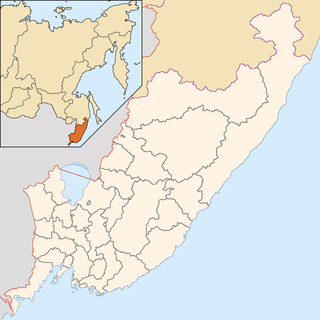
The temperate rainforests of the Russian Far East are within the Russian federal subjects Primorsky Krai and Khabarovsk Krai and contains the Sikhote-Alin mountain range. Found within the Russian Federation, this area is one of the most productive and diverse forests in the world and also contains one of the highest endangered species densities on Earth. While most temperate rainforests around the world have retained only a fraction of their historical range, these forests maintain the majority of their former range and almost all of their historical biodiversity. The region is also notable for having what has become the last remaining large tract of viable habitat for the critically endangered Amur tiger and Amur leopard.
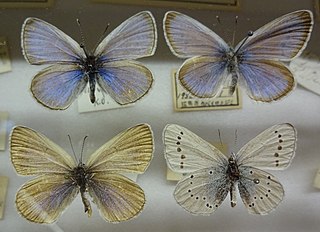
Glaucopsyche lycormas is a butterfly of the family Lycaenidae. It is found in the East Palearctic in Siberia, Mongolia, China, Korea and Japan.

Boloria iphigenia is an east Palearctic butterfly in the family Nymphalidae (Heliconiinae). It is found in Japan, east Amur, Ussuri and northeast China
Carcina luridella is a moth in the family Depressariidae. It was described by Hugo Theodor Christoph in 1882. It is found in the Russian Far East and Japan.
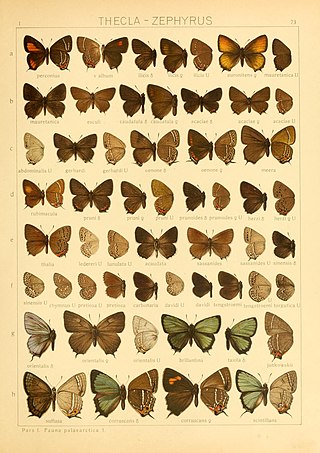
Chrysozephyrus brillantinus is a small butterfly found in the East Palearctic that belongs to the lycaenids or blues family.














